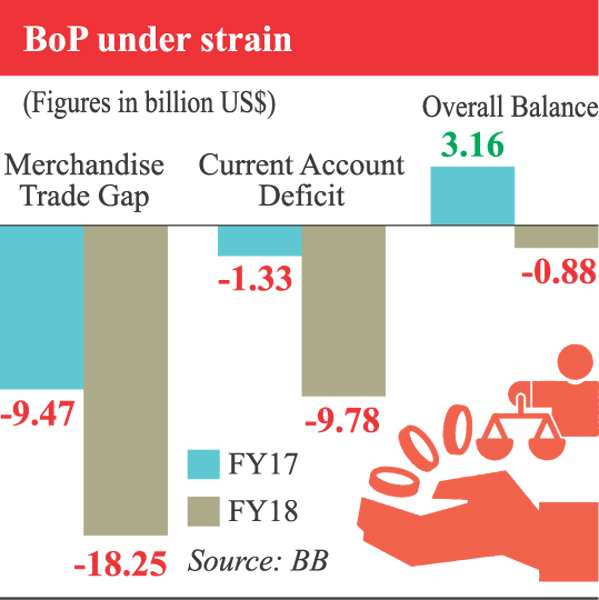
Trade deficit crosses $18b
Experts for exploring new markets alongside diversifying products
Siddique Islam | Tuesday, 14 August 2018
The country's trade deficit passed the $18 billion mark in fiscal year (FY) 2017-18 mainly due to higher import payments than lower export receipts.
Officials said the trade gap with the rest of the world rose to $18.26 billion in the July-June period of the just-concluded fiscal.
It was $9.47 billion in the same period of FY '17. The deficit recorded 92.76 per cent growth last fiscal, according to the latest Bangladesh Bank (BB) statistics released on Monday.
The deficit recorded 92.76 per cent growth last fiscal, according to the latest Bangladesh Bank (BB) statistics released on Monday.
The data showed import expenses jumped by more than 25 per cent, but export earnings were recorded over 6.0 per cent growth.
The overall imports rose to $54.46 billion in the July-June period of FY '18 from $43.49 billion in FY '17.
In contrast, export income stood at $36.20 billion in FY '18 against $34.02 billion in the previous fiscal.
Both economists and BB officials have recommended taking effective measures to expedite export earnings through exploring new markets to narrow the gap.
"The policymakers should explore new export markets along with diversifying products," said Mustafa K Mujeri, former director general of Bangladesh Institute of Development Studies (BIDS).
Citing leather goods, the senior economist told the FE that there is scope to increase export earnings from other products apart from apparel.
A senior BB official spoke of the government's move to explore new markets to boost foreign earnings.
The higher trade deficit further pushed up the current-account deficit despite an uptrend in remittance inflows, he told the FE.
The current-account deficit reached $9.78 billion during the July-June period of FY 18 against $1.33 billion in the preceding year.
The inward remittance, however, climbed by more than 17 per cent to $14.98 billion in FY '18 from $12.77 billion in FY '17.
"Macro-economic stability may be hampered if the current-account deficit continues," explained Mr Mujeri, also the former chief economist of the BB.
He said the policymakers should ensure the receipt of hassle-free remittance with lower cost that will help boost the inflows further.
The higher inflow of medium- and long-term loans helped maintain a robust surplus in the financial account in FY '18, according to the BB officials.
The financial account recorded a surplus of $9.08 billion despite the falling trend in the inflow of foreign direct investment (FDI).
Such surplus was $4.25 billion in FY '17.
"The FDI fell slightly in FY '18, particularly in the telecommunications sector," an official said.
The gross FDI inflows decreased by 7.90 per cent to $2.80 billion in FY '18 from $3.04 billion a year earlier, the BB data showed.
The net FDI flow also dropped by 4.23 per cent to $1.58 billion from the previous $1.65 billion.
The higher gap in trade and current-account reflects the growing imbalance in the external account.
It creates mounting pressure on the overall balance of payments (BoP).
The country's BoP slid to $885 million in FY '18 after a surplus of $3.17 billion a year ago.
The BB official, however, expects that the BoP will turn into a positive territory by the end of this fiscal from the existing level.
"The overall import payment pressure on the economy may decrease this fiscal due to bumper production of rice," the central banker argued.
The overall import increased significantly in FY '18, mainly due to high imports of food grains, fuel oils and capital machinery, according to the BB officials.
siddique.islam@gmail.com